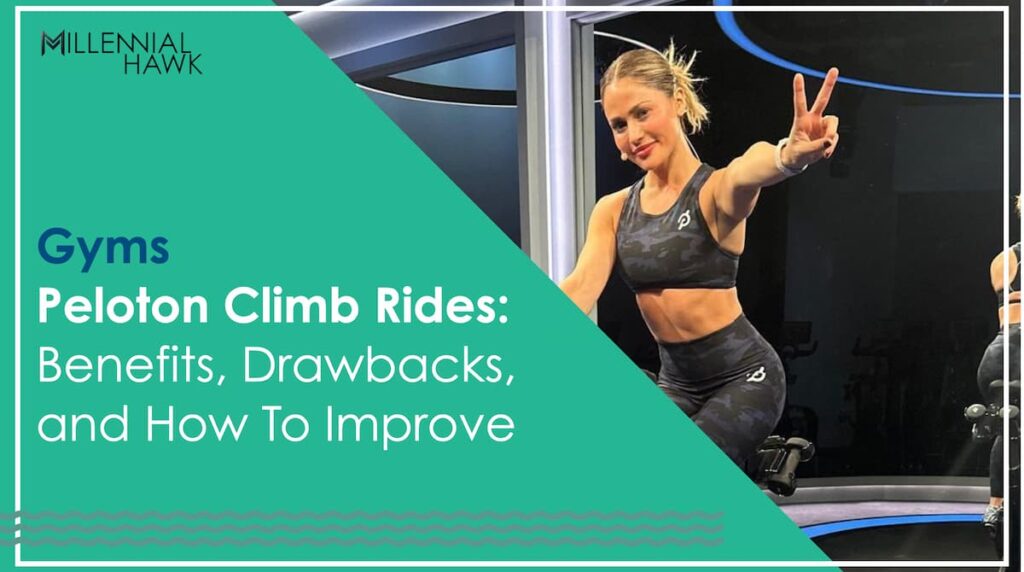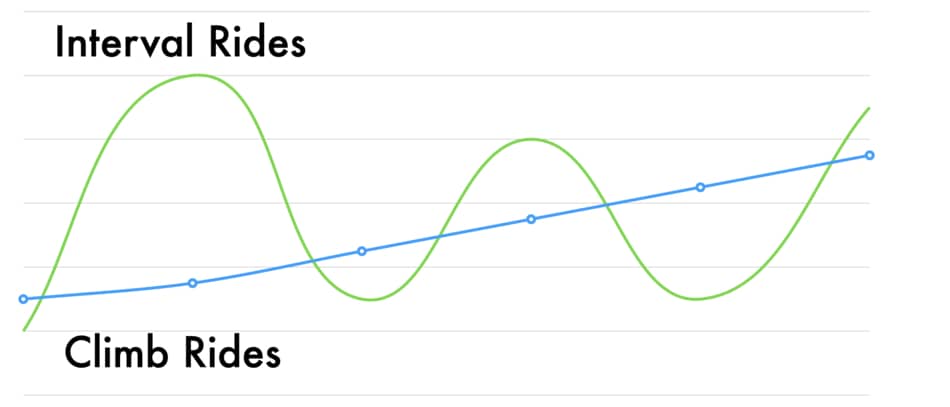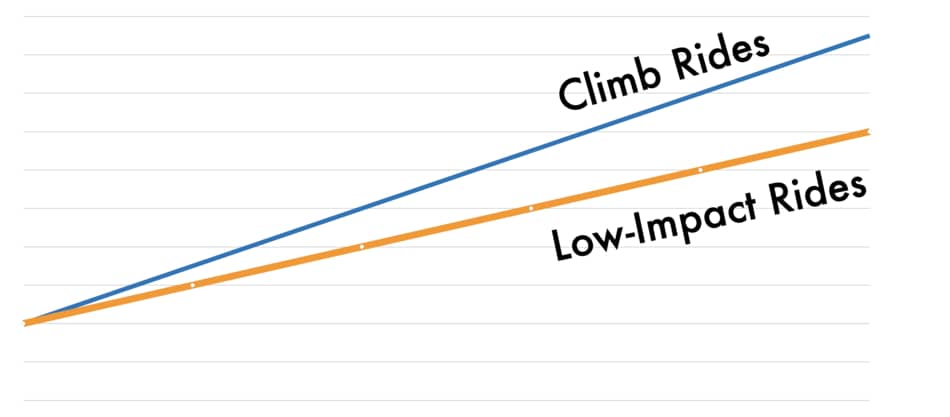
Peloton climb ride is all about simulating uphill cycling, making you feel the heat all over your body, especially in your glutes, hamstrings, quads, and lungs. They’re the fifth most popular cycling workouts on Peloton, with 15+ new rides monthly in English, German, and Spanish, suitable for all fitness levels.
Peloton climb rides work by adding resistance slowly to gradually increase the intensity. You can choose from over 360 workouts, with durations ranging from 10 to 60 minutes. Some top Peloton climb rides are the 30-minute Climb Ride with Mila Lazar and the 60-minute Climb Ride with Cliff Dwegner. If you’re into scenic climbs, don’t miss the Haleakala Volcano Climb—it’s a real gem!
Peloton climb rides have boosted my performance, leading to not only a higher FTP score but also better body composition. My usual Peloton climb settings involve combining a short climb with a quick HIIT session since most workouts are around 20-30 minutes and I like to do them one after the other. If that seems like a lot, don’t worry, Peloton offers alternative rides like Intervals, HIIT, Hills, and even Low Impact HIIT rides.
What are the Peloton Climb Rides?
Peloton Climb Rides are specialized cycling classes designed to simulate uphill cycling, utilizing increased resistance and varying cadence to mimic the experience of climbing hills. The purpose of these rides is to provide an intense workout focusing on lower body strength and cardiovascular endurance, suitable for all fitness levels and particularly beneficial as a low-impact alternative to high-intensity exercises.
I improved my power output and reduced my fat percentage while having fun with Peloton climb rides. They dramatically enhanced my performance, leading to a better FTP score and body composition. The higher resistance of these rides activated more muscle fibers, giving me faster and more effective results.
The advantages of Peloton Climb rides include their effectiveness in building leg strength, enhancing endurance, and providing a challenging yet achievable workout for beginners and experienced cyclists alike. However, the drawbacks include the potential for increased strain on the knees and lower back, and the need for a higher level of motivation due to the challenging nature of sustained uphill cycling simulations.
What are the Benefits of Peloton Climb Rides?
The benefits of Peloton climb rides include enhanced FTP scores, increased time efficiency, providing engaging music, and contributing to improved satiety.
- Enhanced FTP Score: Peloton climb rides require higher resistance, which translates into higher power output. Additionally, uphill rides often necessitate a transition from a seated to a standing riding position. This allows you to engage more muscle groups and generate higher watts. Riding out of the saddle is an opportunity to push myself, and I’ve achieved some of my best PRs during climb rides. However, it’s only sustainable for short rides, as I can train intensely for 10 to 30 minutes and recover. If placed on a climbing ride lasting 90 minutes or more, maintaining 200 to 300 watts becomes more challenging.
- Increase Time Efficiency:
Peloton climb rides offer efficient workouts, even in short durations, making them ideal for busy individuals, especially classes with instructors like Ben Alldis or Robin Arzon. The best times for these sessions are in the morning or late afternoon, helping boost energy and maintain focus and productivity throughout the day. Working from home allows flexibility in choosing the workout time, treating it as an energy booster for work. - Provide Engaging Music: Peloton climb rides offer better music for workouts compared to HIIT or Endurance rides. A 2020 study by Peter C Terry from the University of Southern Queensland has shown that listening to music during exercise not only reduces perceived exertion but also enhances physical performance and promotes a more positive affective valence. The songs in climb rides, with a tempo of 90 to 130 bpm, including pop and metal tracks, have a clear and intuitive rhythm, making it easy to coordinate your pedal strokes with the beat and match the cadence to the music.
- Improves Satiety: A 2019 study by Saleh Afrasyabi from the University of Isfahan suggests that short bursts of aerobic exercise enhance post-meal fullness in both lean and obese individuals, making shorter Peloton climb rides preferable as they leave me feeling less hungry compared to high-impact sessions. Most workouts have a positive impact on satiety and can reduce spontaneous food cravings, but there’s a strong correlation between body composition and workout intensity.
- Helps To Build Muscle: The peloton climb rides do build more muscle because extra resistance leads to better motor unit recruitment in the muscle. However, optimal hypertrophy requires a longer period of training to increase muscle size compared to typical resistance training.
What are the Drawbacks of Peloton Climb Rides?
The main drawback of Peloton climb rides is their high intensity and challenging nature. These workouts require constant resistance adjustments, challenging both cardiovascular fitness and muscular endurance, with an average power output ranging from 200 to 300 watts, making them intense but still allowing for continuous conversation during regular breathing.
Peloton Climb rides are considered one of the toughest workouts on the app. That’s becasue you constantly add more resistance, which challenges both cardiovascular fitness, as well as muscular endurance.
What are the Best Peloton Climb Rides?
The best Peloton climb rides can vary depending on individual preferences and goals, and here are three examples to consider:
- 30 min Climb Ride with Denis Morton: This ride offers a longer duration, allowing for a more sustained climb experience and potential for greater intensity.
- 15 min Climb Ride with Sam Yo For those with limited time, a shorter 15-minute climb ride with Sam Yo can provide a quick and effective hill training session.
- 20 min Climb Ride with Emma Lovewell: Emma Lovewell’s ride provides a middle-ground duration, suitable for those seeking a balanced challenge between shorter and longer climb rides.
The best climb ride for you ultimately depends on your fitness level, time availability, and personal preferences for instructors and ride durations.
Which is the Hardest Peloton Climb ride?
The hardest Peloton climb ride is typically the 45-minute class with Matt Wilpers, known for its difficulty level of 9.2, characterized by consistent resistance additions and minimal rest intervals. The easiest Peloton climb rides are typically 10-minute workouts, designed for those seeking a shorter yet effective hill training session.
How To Use Peloton Climb Rides for Weight Loss?
To use Peloton climb rides for weight loss, consider the following approaches.
- Progression from low-impact rides: If you’re already an experienced cyclist and primarily do low-impact or power zone endurance rides, transitioning to climb rides can be a satisfying challenge. These rides serve as a natural “level-up” from low-impact classes.
- Alternative for HIIT rides: For beginners looking to improve quickly without the intensity of high-intensity interval training (HIIT), Peloton climb rides can serve as a suitable substitute. HIIT rides can be effective but may require longer recovery times for beginners, making climb rides a less demanding yet consistent option.
- Stay Consistent: Climb rides provide a less taxing workout option, making it easier to maintain consistency in your fitness routine, which can contribute to weight loss over time.
How often should you do Peloton Climb Rides?
You should aim to do Peloton Climb Rides one to two times per week as part of a balanced workout routine. This frequency allows for adequate muscle recovery while effectively building strength and endurance.
How to get better at Peloton Climb Rides
To improve your performance in Peloton climb rides, focus on adding more Peloton strength classes into your weekly workout plan, increase training volume, and use the road bike when possible.
- Add Peloton Strength Classes: Numerous studies have shown that “strength training improves cycling performance, utilization of VO2max, and cycling economy” (Vikmoen et al. 2016). This means that engaging in exercises like squats, lunges, deadlifts, and step-ups can lead to improved power output and make climb rides more manageable.
- Increase Training Volume: Studies on bike commuters have shown that even low-intensity cycling, like commuting to work, can lead to significant improvements in physical performance, similar to specific training programs (Hendriksen et al. 2000). So, staying consistent with your climb rides, even at a moderate intensity, can yield positive results.
- Use Road Bike: Riding outdoors is a great way to mix things up and practice real hill climbs, helping you improve your bike handling skills and track your progress. Initially, you might experience leg soreness when tackling hills, but with time, your body adapts, becoming more efficient.
Which Peloton Rides are similar to Climb Rides?
Peloton rides that are similar to Climb Rides include Intervals and Low Impact Rides. Both focus on controlled resistance and cadence changes, offering a similar balance of intensity and endurance training.
What is the difference between Peloton Climb Rides and Intervals?
The key difference between Peloton Climb Rides and Interval rides lies in their intensity and impact on the body. Interval rides, including High-Intensity Interval Training (HIIT), stress the cardiovascular system more by alternating between high-intensity bursts and short recovery periods, leading to improvements in fitness, body composition, and even cognitive function. In contrast, Climb Rides maintain a steady intensity level between tempo and lactate threshold, making them less taxing and suitable for more frequent sessions without the need for extended recovery periods.

What is the difference between Peloton Climb Rides and Low Impact?
Peloton Climb Rides and Low Impact rides are both beginner-friendly and involve progressive overload, but they differ in intensity and purpose. Climb Rides are more challenging and focus on building strength and endurance, whereas Peloton Low Impact rides are gentler, making them ideal for active recovery or maintaining fitness for endurance events. While Climb Rides demand more energy and are less suitable for active recovery, Low Impact rides can be used more frequently, even daily, without overstraining the body.

